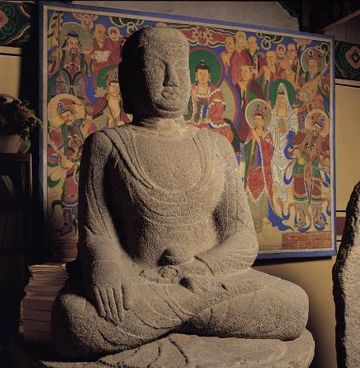"상주 증촌리 석조여래좌상"의 두 판 사이의 차이
Mkichukova (토론 | 기여) (→영문) |
|||
| 29번째 줄: | 29번째 줄: | ||
===영문=== | ===영문=== | ||
'''Stone Seated Buddha in Jeungchon-ri, Sangju''' | '''Stone Seated Buddha in Jeungchon-ri, Sangju''' | ||
| + | |||
| + | This Buddha statue symbolizes Bhaisajyaguru who is believed to possess the power to heal illness and prolong one’s life. It is presumed to have been made in the 8-9th centuries during the Unified Silla period (668-935). | ||
| + | |||
| + | The Buddha statue is sitting on an octagonal pedestal engraved with lotus designs and such pedestals were a style largely made in the 8th century. In his left hand, he is holding the medicine bowl next to his belly. This hand gesture is a defining characteristic of Bhaisajyaguru. His face is expressed with long, narrow eyes, small mouth with no smile, and a flat jaw. The three creases encircling the neck, which represent the “three destinies” of afflictions, actions, and suffering, are carved, and traces of repairs with cement remain. His robe is draping over either shoulder and it is finely expressed in accordance with his body. The hole on the backside of the Buddha statue suggests that the halo is presumed to have been made separately and inserted, but currently the halo no longer remains. | ||
===영문 해설 내용=== | ===영문 해설 내용=== | ||
2020년 10월 28일 (수) 23:34 판
| 상주 증촌리 석조여래좌상 Stone Seated Buddha in Jeungchon-ri, Sangju |
|
 상주 증촌리 석조여래좌상, 국가문화유산포털, 문화재청. |
|
| 대표명칭 | 상주 증촌리 석조여래좌상 |
|---|---|
| 영문명칭 | Stone Seated Buddha in Jeungchon-ri, Sangju |
| 한자 | 尙州 曾村里 石造如來坐像 |
| 주소 | 경상북도 상주시 함창읍 증촌2길 10-13 (증촌리) |
| 지정번호 | 보물 제120호 |
| 지정일 | 1963년 1월 21일 |
| 분류 | 유물/불교조각/석조/불상 |
| 시대 | 통일신라 |
| 수량/면적 | 1구 |
| 웹사이트 | 상주 증촌리 석조여래좌상, 국가문화유산포털, 문화재청. |
|
|
|
해설문
국문
상주 증촌리 석조여래좌상은 약사여래가 앉아있는 모습을 돌에 조각한 불상이다. 정확한 조성 시기는 알 수 없지만 불상의 신체 비례나 얼굴의 세부 표현 등으로 미루어 보아 통일신라 시대 후기에 만들어진 것으로 보인다. 통일신라 중기의 풍만하고 균형있는 표현 양식을 계승하면서도, 그것이 형식화되어가는 모습을 포착할 수 있다.
불상은 오른손으로 무릎을 짚고 왼손으로 약 그릇을 들고 있어서 약사여래불을 형상화하였음을 알 수 있다. 길게 뜬 눈, 미소 없는 작은 입, 군살 붙은 턱 등이 인상적이다. 옷은 양쪽 어깨를 감싸고 몸을 따라 얇게 표현되었다. 연꽃무늬가 새겨진 8각의 받침대에 앉아있는데, 이는 8세기에 많이 나타나는 양식이다. 한편 이곳 탑동은 신라 문무왕 16년(676)에 의상대사가 창건한 상안사가 있던 터라고 전해지는 곳이다.
영문
Stone Seated Buddha in Jeungchon-ri, Sangju
This Buddha statue symbolizes Bhaisajyaguru who is believed to possess the power to heal illness and prolong one’s life. It is presumed to have been made in the 8-9th centuries during the Unified Silla period (668-935).
The Buddha statue is sitting on an octagonal pedestal engraved with lotus designs and such pedestals were a style largely made in the 8th century. In his left hand, he is holding the medicine bowl next to his belly. This hand gesture is a defining characteristic of Bhaisajyaguru. His face is expressed with long, narrow eyes, small mouth with no smile, and a flat jaw. The three creases encircling the neck, which represent the “three destinies” of afflictions, actions, and suffering, are carved, and traces of repairs with cement remain. His robe is draping over either shoulder and it is finely expressed in accordance with his body. The hole on the backside of the Buddha statue suggests that the halo is presumed to have been made separately and inserted, but currently the halo no longer remains.
영문 해설 내용
이 불상은 모든 중생의 질병을 고치고 수명을 연장해주는 부처인 약사여래를 나타낸 것이다. 통일신라시대인 8-9세기에 만들어진 것으로 추정된다.
불상은 연꽃무늬가 새겨진 8각 대좌에 앉아있으며, 이러한 대좌는 8세기에 많이 만들어진 양식이다. 왼손은 배 앞에서 둥근 약그릇을 들고 있는데, 이는 약사불을 상징하는 가장 큰 특징이다. 얼굴에는 길게 뜬 눈, 미소 없는 작은 입, 군살 붙은 턱 등이 표현되어 있다. 목에는 번뇌, 업, 고통을 상징하는 삼도가 새겨져 있는데, 부분적으로 시멘트로 보수한 흔적이 남아 있다. 옷은 양쪽 어깨를 감싸고 몸을 따라 얇게 표현되었다. 불상의 등 쪽에 구멍이 있는 것으로 보아, 광배를 따로 만들어 꽂았던 것으로 보이지만, 현재 광배는 남아 있지 않다.
참고자료
- 국가문화유산포털 http://www.heritage.go.kr/heri/cul/culSelectDetail.do?ccbaCpno=1123701200000&pageNo=1_1_1_1 -> 경상북도 상주군 용화사에 모셔져 있는 높이 1.68m의 석조불상이다. 거의 직사각형의 얼굴 형태를 하고 있으며, 어깨와 팔, 다리 등 신체 각 부분이 직선적이고 각이 진 모습이어서 전체적인 인상이 강인하며 경직된 느낌을 준다. 목에는 3줄의 삼도(三道)가 있고 양 어깨를 감싸고 있는 옷은 신체에 밀착하여 얇게 표현되었다. 오른손은 무릎에 대고 있으며 왼손에는 약 그릇을 들고 있어 약사여래불을 형상화한 것이 분명하다. 광배(光背)는 남아 있지 않으며, 대좌는 8세기에 많이 나타나는 8각의 연꽃무늬 대좌로 안정감이 느껴진다. 수평으로 길게 뜬 눈, 미소없는 작은 입, 군살 붙은 턱 등의 세부표현은 고려시대 불상으로 옮겨가는 과도기적인 작품임을 알려준다. 통일신라 중기의 풍만하고 균형있는 표현양식을 계승하면서도 그것이 형식화되고 경직화되어가는 특색을 잘 보여주는 통일신라 후기의 작품이다.
- 구름의 달, 다음 블로그 http://m.blog.daum.net/dldml2xhd/15920059?np_nil_b=1 -> 상세 이미지 확인 가능 / 광배 구멍, 발바닥 등 특징 언급
- 문화재대관 보물편 : 석조 Ⅱ(개정판), 문화재청, 2019 -> 시멘트 보수 언급 / 조성 시기 9세기 전반으로 편년함 ; 기존 설명과 차이가 있어 ‘8-9세기’로 명시함.